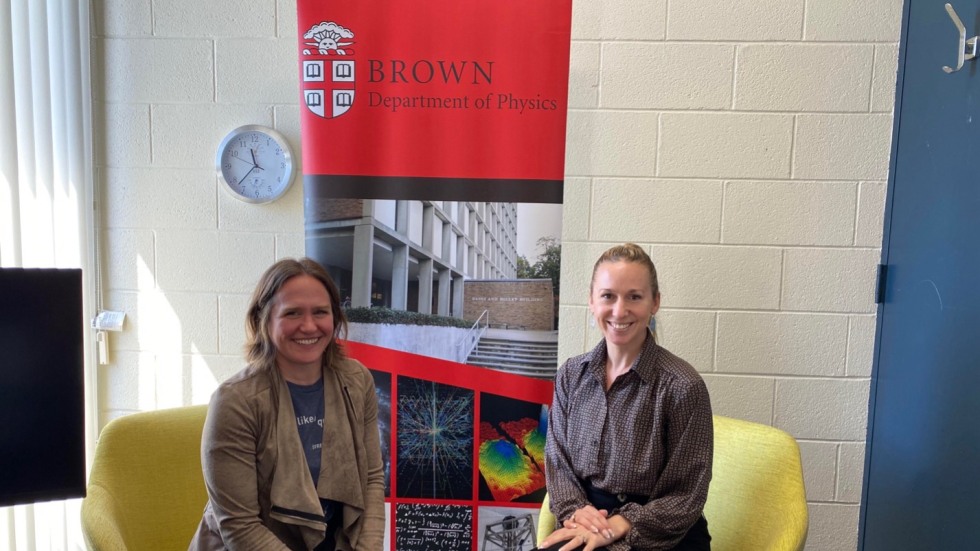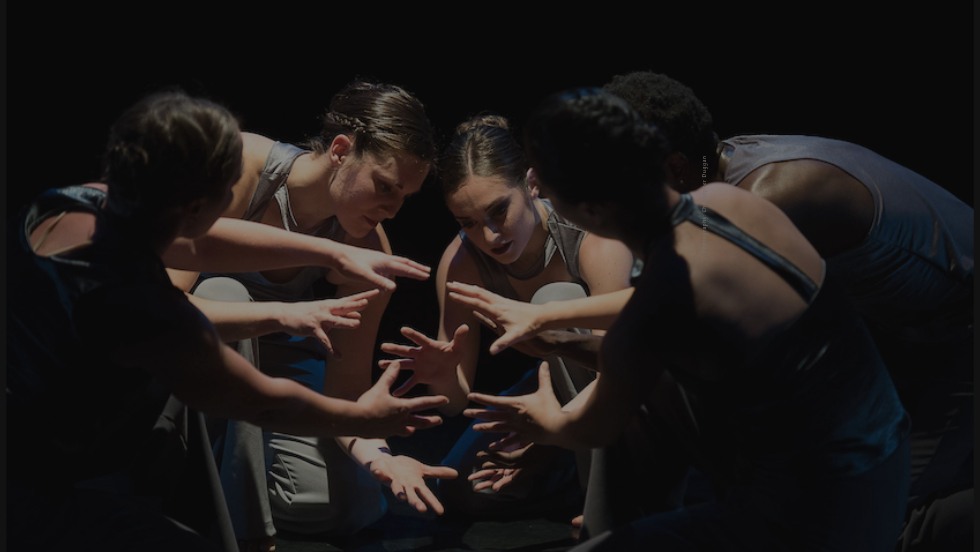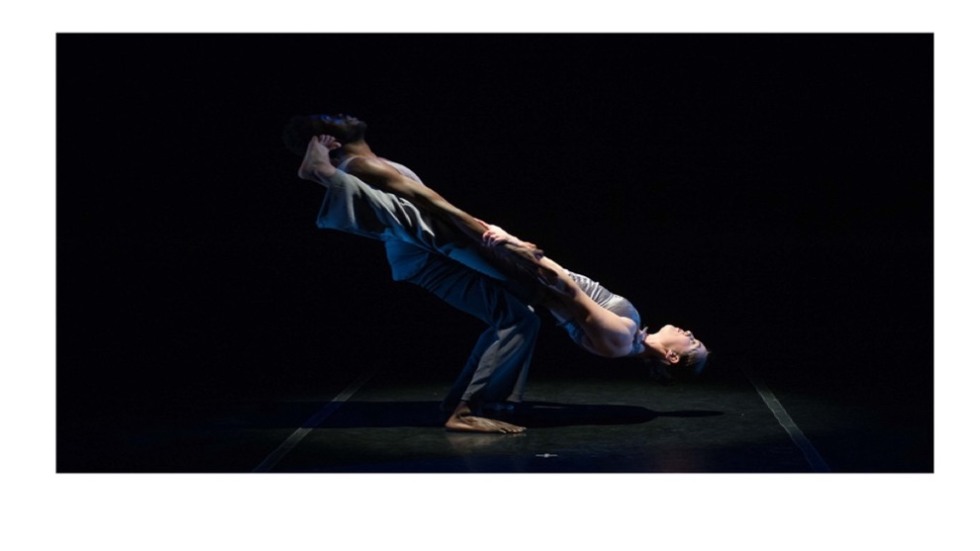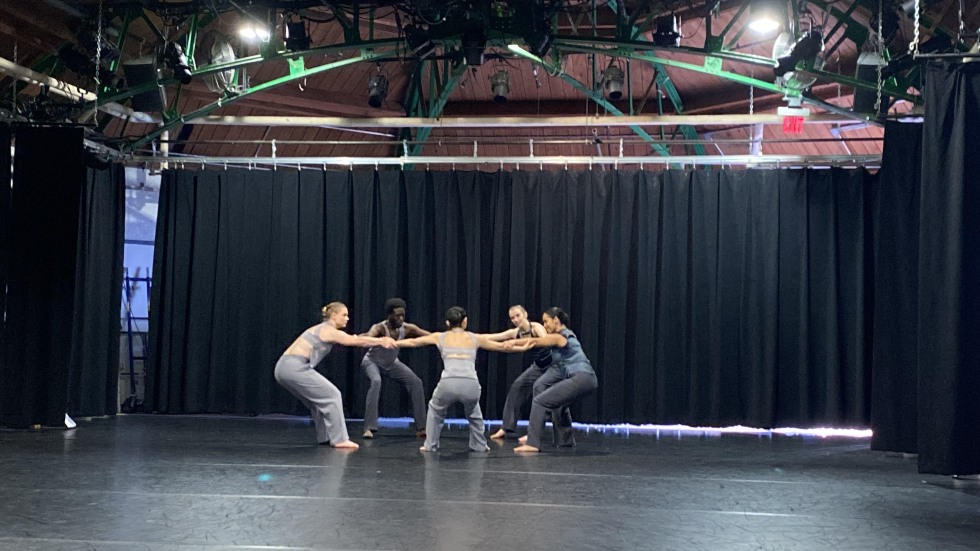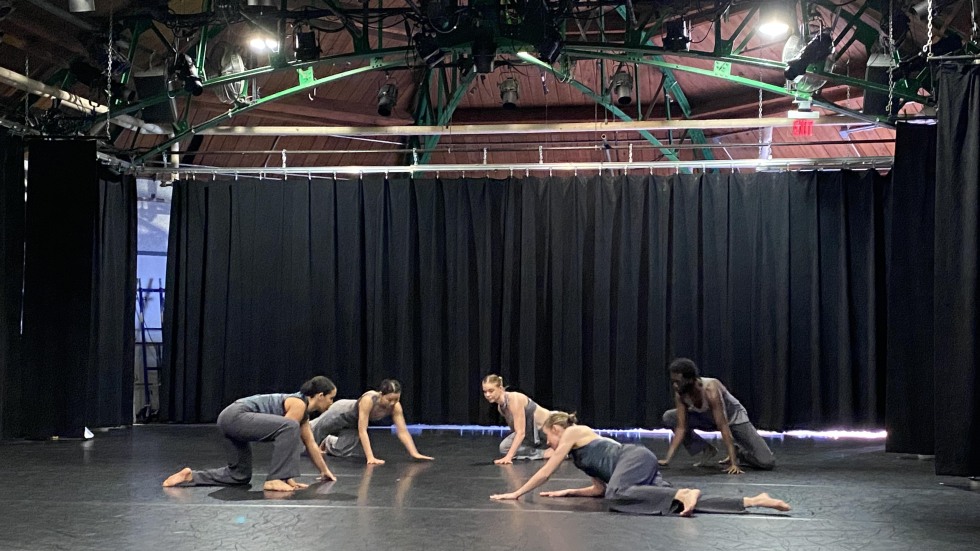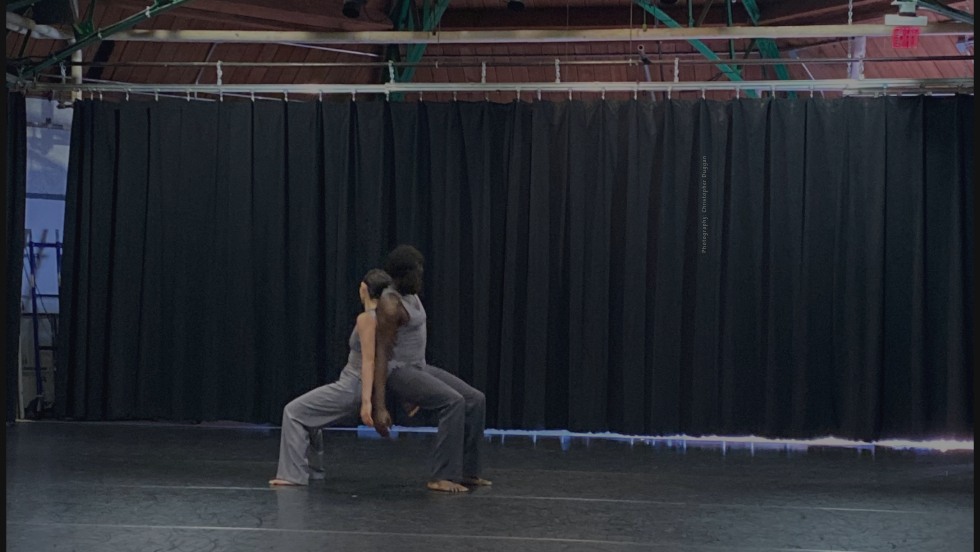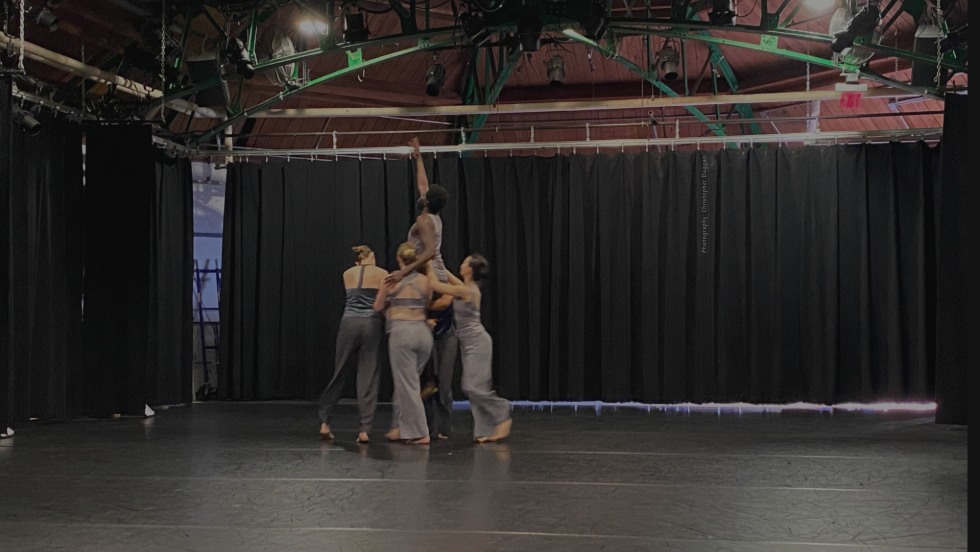As an academic department devoted to studying physics and committed to diversity and inclusion, how do you top an inaugural artist-in-residence series featuring a renowned jazz saxophonist and mathematician? You find a celebrated modern dance company that performs an interpretation of quantum mechanics, and you bring them to Brown University.
That’s exactly what Brown Physics Department Diversity and Inclusion Action Plan (DDIAP) committee chair Professor Ian Dell’Antonio did this spring, making the connection through Professor Stephon Alexander to SYREN Modern Dance, a New York City-based dance company whose artists have been named United States Cultural Ambassadors by the Department of State. Professor Alexander instituted the artist-in-residence series in 2022 in furtherance of the DDIAP committee’s mission of encouraging inclusion and bringing diverse ideas into the department. Through its innovative interpretations of quantum mechanics concepts, SYREN’s one-day residency on April 20th, 2023, showed the physics community new ways to think about physics.
Fostering Collaboration and Inclusion
In SYREN’S piece “Red and Blue, Bitter and Sweet,” the disparate worlds of physics and dance collide, creating an unexpected, fascinating synergy. The piece is an exploration of quantum mechanics theories of entanglement, wave/particle duality, the uncertainty principle, and superposition. Incoming DDIAP Committee Chair Professor Alexander explained why he feels SYREN’s piece was ideal for the second installment of the artist-in-residence series, saying, “The piece on quantum entanglement by SYREN went beyond the expectations of the mission of our DIAP. The engagement brought students together to collaborate across departments. The piece reflected the exciting ways modern physics and dance can be intertwined and expand our imagination and knowledge of physics and the arts. It enabled our students and department to forge a more welcoming and inclusive department and community.”
SYREN co-artistic directors Kate Sutter and Lynn Peterson founded SYREN Modern Dance in 2003, and, in 20 years, they have yet to experience anything like their day at Brown. They found the Physics Department to be warm and welcoming and were impressed by how well-organized the day was. The company’s packed day at Barus & Holley included a tour of the physics labs, meetings with the Physics Department faculty, and a pizza lunch with students. SYREN invited the Physics community to a movement workshop, in which participants were inspired to move their bodies by concepts typically encountered in the classroom, taking them on a journey of discovery and an exploration of new ways to think about physics.
SYREN became interested in the intersection of science and dance in 2015. For both co-artistic directors, the physical expression of quantum mechanics was a natural extension of their curiosity. According to Kate, the company spent much of its organizational journey presenting many themes and points of departure for its work: human experiences, love, the journey of the Sephardic Jewish people, and ancient Egypt.
While Kate’s curiosity about cosmology and physics was “always simmering near the surface,” she never considered bringing it into her choreographic pursuits, feeling she didn’t know enough about it to give it the integrity it deserved in the studio. After some discussion, she and Lynn agreed that to be faithful to the concepts, they would learn more so they could express physics through dance. Not having a science background didn’t deter Kate, Lynn, or their dancers from developing an idea about which they became more passionate the more they learned.
Kate said everything just “ignited” in the studio while working through the ideas with the dancers, who enjoyed the exploration of physics and where that took them creatively. A natural extension of that passion was to develop a piece expressing how they felt about entanglement. Learning about physics gave SYREN a “broad ability to program, create work, do workshops, meet new people, and find new communities,” Kate said.
Physics in Movement: Getting from Here to There
Lynn described the creative process as a collaboration between the ideas that inspired Kate and the dancers’ exploration of those ideas. It wasn’t so tightly choreographed that the dancers were constrained; there was room for their journey as dancers in the work to develop their interpretation, making the work more meaningful to each dancer. Lynn explains that she provides the dancers with artistic freedom within the framework of the piece. The dancers’ process may allow them to feel, for example, that they don’t have to think about the uncertainty principle at an exact moment in the piece or at a specific count in the music. They have the freedom to find their journey within, she says, and “maybe at that moment, they won’t be thinking about the uncertainty principle; maybe they’ll be thinking about their grandmother who passed away. That’s where we each can live with it in the universe. Exploration can always play a role in the journey of the dance, so it can be different every time we run it. All of this information about quantum mechanics is in our minds and flows through our bodies, so it’s up to each of us as performers to interpret it. Then it is up to the viewer to take from it what they will.”
Kate brought books on quantum mechanics into the studio, and the company read and discussed the concepts. Then, each dancer moved off to translate their ideas into movement, letting their imaginations move their bodies into how they conceptualized quantum entanglement, at times representing “things banging around and colliding,” as Kate puts it. As they moved around the studio, Kate saw the beginnings of a performance take shape and began to organize the dancers, having lengthy discussions and individual and collective movement sessions, translating their ideas of physics into movement and form.
Lynn is quick to interject that their goal was not to become physicists. She emphasized that their role as dancers and dance makers is to take a point of departure and inspiration and then bring it into the space they know – the studio – and develop the concept with their bodies. They were moved to learn all they could; that knowledge allowed them to create a beautiful synergy between the worlds of physics and dance. Lynn says, “We were able to create something and then connect it to our experience. So many people are fascinated by physics. It lives inside of us and in the world around us. We all intersect with it daily, even though we’re not thinking about it. So, it’s exciting to remember that we can learn little nuggets of information and then bring them into our world and be surprised by where it takes us.”
In the creative process, interpretation is key. It’s not so much the exact principle of quantum entanglement as would be encountered in the classroom, but rather the performer’s interpretation of what that process entails. Kate explained that when the dancers depict quantum entanglement, their dance represents particles having the same experience but at two different places in the universe. As one dancer performs a movement, another grasps that dancer’s shoulder, moving it in a circular motion. At the same time, another dancer mirrors those movements across the stage, their shoulder also manipulated by another dancer. The movements are related but occur simultaneously in different areas of the stage. These visuals came to Kate’s mind when she read about quantum entanglement.
She says there are times when audience members pick up on what is being represented on stage but that “certainly in some audiences nobody would ever know that at that moment I am demonstrating this exact thought; I would argue that something is going to resonate with them. They may realize that there’s a connection between these two groups of people on stage moving simultaneously, and that’s enough. Where the audience goes with what that connection means to them is why we’re artists. We found one point of departure to demonstrate that, but any given person will respond differently to that, and that’s why we do what we do.”
Brown Physics Inspires
Do you feel that anything you learned at Brown Physics will inform your interpretation of quantum mechanics for future performances of “Red and Blue, Bitter and Sweet?”
Lynn: “Absolutely. In this case, a community of scientists is part of the layering of experiences that I pull from when performing the work. The day at Brown is now part of the history of where the dance has taken us and will no doubt be part of how we think about the work moving forward.”
Kate: “Every time we intersect the scientific community, we become more curious. Our goal with this dance is to inspire curiosity and a quest for knowledge; that is the spirit with which we entered the labs. It's a world we don't often experience, and we treasure it when we do.”
Physics: Blowing Minds Everywhere
According to Lynn, SYREN’s whirlwind day at Brown was the exception and not the rule for the company’s site visits. She said that the company is often somewhere to perform, teach, or talk, but at Brown, they had the opportunity to do all three with the community. While those whose studies and research at Brown Physics may take for granted their access to all things physics, bringing in a fresh perspective about physics reminds one of what a special place Barus & Holley is. For example, of all the day’s activities, Kate’s favorite was touring the labs with graduate students and seeing the equipment, such as magnets and microscopes. Explaining her awe, she said it was remarkable how tiny things were. “It was amazing to see how incredibly small the graphene samples were and how precise everything had to be.” For Lynn, the labs were “so vastly different from anything I experience on any given day. The entire atmosphere kind of blew my mind.” A reminder of how fortunate we are that we get to be in the place where physics happens!
Engaging with the Work
Lynn laughs when explaining that Brown physics faculty members were “super interested in how we were making the dance.” In her conversations with physics professor Ian Dell’Antonio, she said he understood immediately how entanglement was being represented through the dance but that, in general, “there is no right or wrong interpretation. When we have an audience like this who can relate to the information more deeply, it’s always fascinating because they have a different connection to the source material than somebody else might.” Kate says that sometimes the opposite happens when the audience brings new and unexpected insights with their interpretations of the quantum entanglement dance. When that happens, she says, the response is no less valid. Unique interpretations and reactions are edifying to the co-directors, and they incorporate those moments of clarity into future performances. They welcome the audience to engage with the work however they can to make dance more accessible. “People don’t have to ‘get it’ (quantum entanglement) before they walk in the door. We simply ask them to come into our space and watch our performance because we need them to witness it for our process to be complete. Hearing people’s reactions, from the super specific to the super random, shows us that they connected to it and that propels us forward.”
The Intersection of Physics and Dance: Where the Magic Happens
The co-directors agree that at performances of “Red and Blue, Bitter and Sweet,” an audience of physics students and faculty is more inquisitive about the artistic process, whereas a general audience is more fascinated with the representations of scientific aspects of the performance. For this reason, they always have a physicist on hand for the post-performance Q&A to address the more technical questions. After touring Brown’s physics labs, the company is more committed than ever to presenting its interpretation of physics concepts in a consumable format. Lynn has heard from audiences who feel they don’t know enough about physics to enjoy the performance, but she insists that isn’t the piece's point. She wants people to know they can enjoy the performance without being experts in physics. “We want to present our interpretation without compromising either the integrity of the information or the high level of physical ability that we have to represent the concepts of quantum entanglement. I think the worlds of dance and physics can combine to allow us to be true to the craft while still welcoming audiences to the world of physics. It’s a magical combination.”
